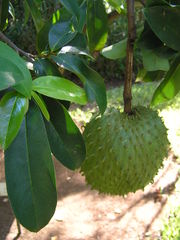Soursop
| Soursop/Guanabana | |
|---|---|
 |
|
| Scientific classification | |
| Kingdom: | Plantae |
| (unranked): | Angiosperms |
| (unranked): | Magnoliids |
| Order: | Magnoliales |
| Family: | Annonaceae |
| Genus: | Annona |
| Species: | A. muricata |
| Binomial name | |
| Annona muricata L.[1] |
|
The soursop (Spanish guanábana, Portuguese graviola, Annona muricata; syn. A. sericea Dunal in Correia, M. P., (1984), A. macrocarpa Wercklé, A. bonplandiana H.B. & K., A. cearensis Barb.Rodr., A. coriacea, Guanabanus muricatus (L.) M.Gómez in Rain-tree) is a broadleaf flowering evergreen tree native to Mexico, Central America, the Caribbean and northern South America. Soursop is also native to Sub-Saharan Africa countries that lie within the tropics. Today, it is also grown in some areas of Southeast Asia. It is in the same genus as the chirimoya and the same family as the pawpaw.

The soursop is adapted to areas of high humidity and relatively warm winters, temperatures below 5 °C/41 °F will cause damage to leaves and small branches, and temperatures below 3 °C/37.4 °F can be fatal. The fruit becomes dry and is no longer good for concentrate.

Common Names: Soursop, Graviola, Guanabana, Brazilian Paw Paw, Corossolier, Guanavana, Toge-Banreisi, Durian benggala, Nangka blanda, Nangka londa (Source: http://www.blackherbals.com/graviola.htm)
Its flavor is described as a combination of strawberry and pineapple with sour citrus flavor notes contrasting with an underlying creamy flavor reminiscent of coconut or banana.
Contents |
Cultivation and uses
The plant is grown as a commercial crop for its 20-30 cm /7.87-11.8 inch long prickly green fruit, which can have a mass of up to 2.5 kg/5.5 lbs.
Away from its native area, there is some limited production as far north as southern Florida within USDA Zone 10; however these are mostly garden plantings for local consumption. It is also grown in parts of southeastern Asia. The soursop will reportedly fruit as a container specimen, even in temperate climates if protected from cool temperatures.

The flesh of the fruit consists of an edible white pulp and a core of indigestible black seeds. The species is the only member of the genus Annona that is suitable for processing and preservation. The sweet pulp is used to make juice as well as candies, sorbets, and ice cream flavorings.
In Mexico it is a common fruit often used for dessert as the only ingredient, or as an agua fresca beverage. Ice cream and fruit bars made of soursop are also very popular. The seeds are normally left in the preparation, and removed while consuming.
In Indonesia, dodol sirsak, a sweetmeat, is made by boiling soursop pulp in water and adding sugar until the mixture hardens. Soursop is also a common ingredient for making fresh fruit juices that are sold by street food vendors. In Vietnam, this fruit is called mãng cầu Xiêm in the South, or mãng cầu in the North and is used to make smoothie, or eaten as is. In Cambodia, this fruit is called "Tearb Barung", literally "Western Custard-apple fruit." In Malaysia it is known in Malay as 'Durian Belanda' and in East Malaysia, specifically the Dusuns of Sabah, it is locally known as 'lampun'. Popularly it is eaten raw when it ripens. Usually the fruits are taken from the tree when they mature and left to ripen in a dark corner whereby they will be eaten when they are fully ripe, i.e., it is soft when you press the fruit. It has a white flower with a very pleasing scent especially in the morning.
Nutritionally, the fruit is high in carbohydrates, particularly fructose. The fruit also contains significant amounts of vitamin C, vitamin B1, and vitamin B2. The fruit, seeds, and leaves have a number of herbal medicinal uses among indigenous peoples of regions where the plant is common.
Health risks
Research carried out in the Caribbean has suggested a connection between consumption of soursop and atypical forms of Parkinson's disease due to the very high concentration of annonacin.[2][3][4][5]
References
- ↑ |Synonyms =
- Annona crassiflora Mart.
- Annona sericea Lam.
- ↑ Lannuzel, A; et al. (2003-10-06). "The mitochondrial complex i inhibitor annonacin is toxic to mesencephalic dopaminergic neurons by impairment of energy metabolism". Neuroscience (International Brain Research Organization) 121 (2): 287–296. doi:10.1016/S0306-4522(03)00441-X. PMID 14521988.
- ↑ Champy, Pierre; et al. (2005-08-02). "Quantification of acetogenins in Annona muricata linked to atypical parkinsonism in guadeloupe". Movement Disorders 20 (12): 1629–1633. doi:10.1002/mds.20632. PMID 16078200.
- ↑ Lannuzel A, Höglinger GU, Champy P, Michel PP, Hirsch EC, Ruberg M. (2006). "Is atypical parkinsonism in the Caribbean caused by the consumption of Annonacae?". J Neural Transm Suppl. 70 (70): 153–7. doi:10.1007/978-3-211-45295-0_24. PMID 17017523.
- ↑ Caparros-Lefebvre D, Elbaz A. (1999-07-24). "Possible relation of atypical parkinsonism in the French West Indies with consumption of tropical plants: a case-control study". Lancet 354 (9175): 281–6. PMID 10440304.
See also
- Cherimoya
- Custard-apple
- Sugar-apple
- Atemoya
- Annona crassiflora
External links
- (Portuguese) Correia, M. P., (1984) Dicionário das plantas úteis do Brasil
- Description of soursop from Fruits of Warm Climates (1987, ISBN 0-9610184-1-0)
- Sorting Annona names
- Soursop / Guyabano Fruit Nutrition
- Rain-tree: Annona muricata
- Soursop List of Chemicals (Dr. Duke's)
Gallery
 |
 |
|
 |
_-_tree_with_fruits.jpg) |
.jpg) |
 Fruit and Spice Park, Homestead, Florida |
 Unbelievable Acres Botanic Gardens, West Palm Beach, Florida |